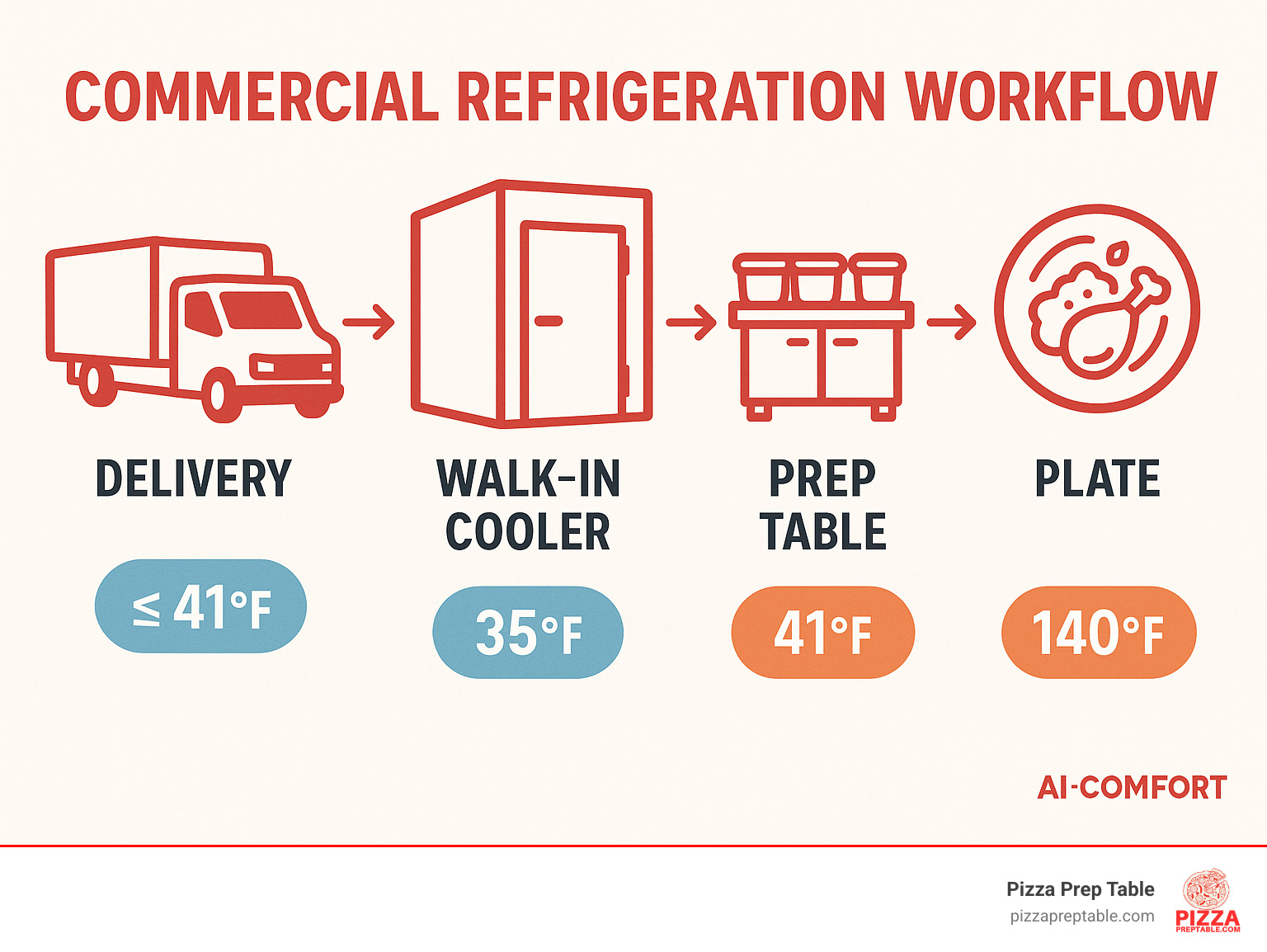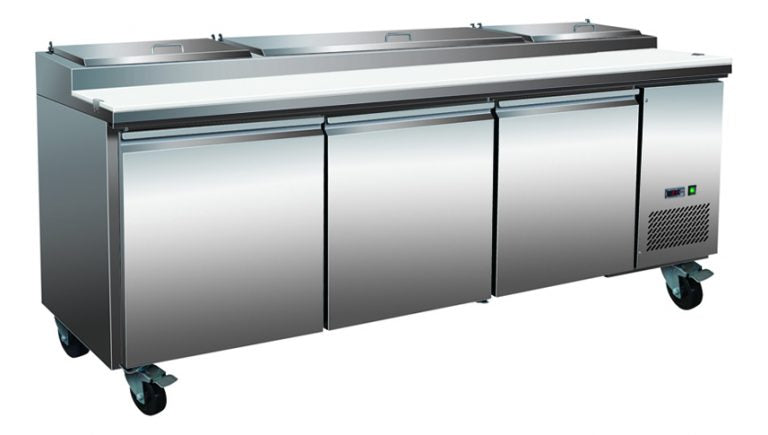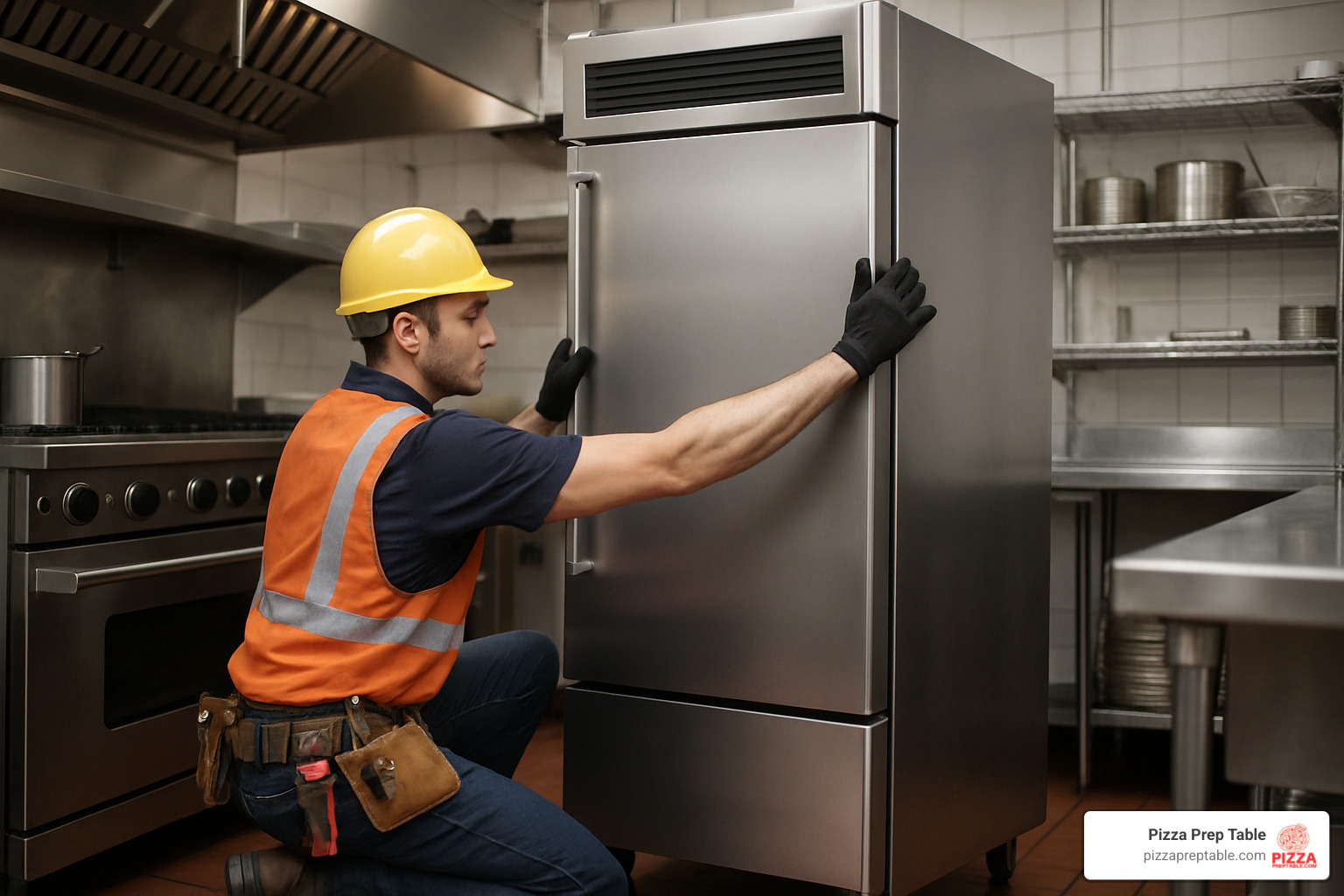
Commercial Fridge Shopping Made Easy (and Cool!)
Share
Why Finding the Right Commercial Fridge for Sale Matters More Than You Think
Looking for a commercial fridge for sale? Here's what you need to know before you buy:
• Reach-in refrigerators: Best for daily access, 23-53 cu.ft capacity, $1,000-$4,000
• Walk-in coolers: Bulk storage solution, 68-1,600+ sq.ft, custom sizing available
• Prep tables: Workspace + refrigeration combo, perfect for pizza/sandwich prep
• Display merchandisers: Glass doors for beverage sales, LED lighting, impulse purchases
• Undercounter units: Space-savers for small kitchens, 6-20 cu.ft typical
The difference between success and spoiled ingredients often comes down to one thing: reliable refrigeration. Commercial fridges aren't just bigger versions of home units - they're built for 24/7 operation with heavy-duty compressors, better insulation, and rapid temperature recovery.
Your customers expect fresh ingredients every time. Whether you're storing pizza toppings at 35°F or displaying cold beverages, the right commercial refrigerator keeps your food safe, your costs down, and your reputation intact.
Research shows commercial refrigerators typically last 10 years with proper maintenance, making them a solid investment for any food business. But with prices ranging from under $600 for small beverage coolers to over $5,000 for large reach-in units, choosing wisely matters.
I'm Sean Kearney, and I've helped countless restaurant owners find the perfect commercial fridge for sale that fits their space, budget, and business needs. From my early sales days to working with major foodservice chains, I've seen how the right refrigeration equipment can make or break a kitchen's efficiency.

Why Invest in a Commercial Refrigerator?
Picture this: it's Saturday night, your restaurant is packed, and your residential fridge just gave up. Half your ingredients are warming up, your prep cook is panicking, and customers are waiting. This scenario happens more often than you'd think.
When you're running a foodservice business, commercial refrigeration isn't just equipment - it's your insurance policy against disaster. Whether you run a busy pizzeria, a corner grocery store, or cater weekend events, the right commercial fridge for sale becomes the silent hero keeping your operation running smoothly.
Here's the reality: commercial units maintain rock-solid temperatures between 33°F and 41°F, that critical zone where harmful bacteria can't multiply but your ingredients stay fresh. They're built for the 24/7 duty cycle your business demands, with rapid pull-down capability that recovers quickly when staff constantly open doors during rush periods.
The NSF certification on commercial units isn't just a fancy sticker - it's your guarantee that health inspectors won't shut you down. And those energy savings? A quality commercial refrigerator typically uses 20-30% less electricity than multiple residential units, delivering solid ROI within the first year.
Consider the math: a typical pizzeria might lose $300-500 monthly to spoiled ingredients with inadequate refrigeration. Over a year, that's $3,600-6,000 in pure waste. A quality commercial unit costing $2,500 pays for itself in prevented spoilage alone, not counting the energy savings, improved efficiency, and peace of mind.
Commercial vs. Residential: The Cold Truth
I've watched too many restaurant owners learn this lesson the hard way. That "bargain" residential fridge from the big box store might seem tempting, but it's like bringing a bicycle to a motorcycle race.
Commercial compressors are three times larger and built for continuous operation, while home units expect to rest between meal times. The duty rating tells the whole story - residential fridges are designed for maybe 8-12 door openings per day, not the 100+ your busy kitchen demands.
Insulation thickness makes a huge difference too. Commercial units pack 2-4 inches of high-density foam compared to the thin 1-2 inches in home fridges. Add in fan cooling that circulates air evenly throughout the cabinet, and you've got consistent temperatures from top shelf to bottom.
The electrical systems differ dramatically as well. Commercial units feature heavy-duty wiring, industrial-grade thermostats, and components designed for constant use. Residential fridges use lighter-duty parts that simply can't handle the stress of commercial operations.
Temperature recovery time showcases the real difference. When you open a residential fridge door for 30 seconds, it might take 15-20 minutes to return to proper temperature. A commercial unit recovers in 2-3 minutes, maintaining food safety even during busy periods.
Trust me, the extra investment upfront beats explaining to your insurance company why you tried to run a restaurant with home appliances.
Business Benefits You'll Feel on the Bottom Line
The real magic happens when you see how proper refrigeration transforms your daily operations. Reduced spoilage alone can save most restaurants $200-500 monthly - those wilted lettuce leaves and sour dairy products add up fast.
Menu consistency becomes effortless when your ingredients stay fresh longer. Your pizza sauce tastes the same on Tuesday as it does on Saturday. Your customers notice this reliability, leading to higher customer satisfaction and repeat visits.
But here's what really matters: your brand image stays protected. One food safety incident from improperly stored ingredients can destroy years of reputation building. Commercial refrigeration with proper temperature logging helps you stay compliant and keeps your business thriving.
Operational efficiency improves dramatically with proper refrigeration. Staff spend less time checking temperatures, rotating stock, and dealing with spoiled products. That time gets redirected to customer service and food preparation - activities that actually generate revenue.
Insurance benefits often go unnoticed until you need them. Many commercial policies require NSF-certified equipment for food service operations. Using residential equipment could void your coverage, leaving you exposed to massive liability if something goes wrong.
Smart operators know that finding the right commercial fridge for sale isn't an expense - it's an investment in operational excellence that pays dividends every single day.
Types of Commercial Fridges at a Glance
Finding the right commercial fridge for sale is easier once you know the basic categories and what each one does best. Use this section as a quick reference, then match the style to your menu, kitchen size, and budget.

Reach-In & Undercounter Workhorses
• Reach-ins (single-, double-, three-door) – 23-53 cu.ft.; quick access for daily ingredients; adjustable shelves; self-closing doors. • Undercounter coolers – 6-20 cu.ft.; slide beneath prep tables or bar tops; full commercial compressors in a compact shell.
Walk-In Coolers for Bulk Storage
Need pallet-size deliveries or weekly stock? A modular walk-in (8' × 8' and up) gives you room to grow, accepts remote or self-contained compressors, and can be expanded later by adding panels.
Merchandisers & Display Kings
Glass-door merchandisers chill drinks while boosting impulse sales. Features to look for: LED lighting, self-closing doors, and digital temperature readouts that make health inspectors smile.
Specialized Solutions
• Pizza prep tables – refrigerated rail for toppings plus a full prep surface.
• Medical / vaccine fridges – tight temperature tolerances with alarms.
• Bar refrigeration – back-bar coolers, keg boxes, and wine units tuned for beverage service.
Knowing which group you belong to keeps you from overspending on bells and whistles you’ll never use—or worse, buying a unit that can’t keep up on Friday night.
Key Features & Buying Checklist
A shiny exterior isn’t enough. Run through this trimmed-down checklist before signing for any commercial fridge for sale.
• Size & capacity – Match cubic feet to peak volume, not average days.
• Temperature range – 33-41 °F is the safe zone; tighter tolerances for sushi, vaccines, or gelato.
• Energy use – Look for ENERGY STAR and R290 refrigerant; lower utility bills pay you back every month.
• Construction – Stainless inside and out resists corrosion and cleans fast.
• Certifications – NSF for food safety, ETL for electrical, DOE or ENERGY STAR for efficiency.
• Warranty & service – At least 3 yrs parts/labor and 5-7 yrs on the compressor; make sure local techs carry parts.
| Feature | Stainless Steel | Galvanized Steel |
|---|---|---|
| Durability | Excellent | Good |
| Cleaning | Easy | Moderate |
| Corrosion Resistance | Superior | Limited |
| Food Safety | NSF Certified | Basic |
| Cost | Higher | Lower |
| Appearance | Professional | Industrial |
| Maintenance | Low | Moderate |
| Lifespan | 15+ years | 8-12 years |
Measure twice, leave six inches of airflow around the condenser, and verify your doorways before delivery—those three steps prevent 90 % of installation headaches.
Budgeting & Where to Find the Best Commercial Fridge for Sale
Price bands give you a starting point:
• Small beverage cooler $500-$1,000
• Single-door reach-in $1,000-$2,500
• Two-door reach-in $2,000-$4,000
• Three-door reach-in $3,000-$5,000+
• Walk-in cooler $5,000-$15,000+
Where to Look
- Online marketplaces (Amazon) – huge selection and user reviews.
- Specialty dealers – expert advice plus install options.
- Local restaurant suppliers – see it, touch it, and arrange service.
- Auctions / liquidations – deepest discounts; inspect before you bid.
Stretch Your Dollars
• Used or refurbished units under 5 years old can save 40-60 %.
• Check utility rebates on ENERGY STAR models.
• Time purchases for end-of-year or model-change closeouts.
Financing Without Freezing Cash Flow
Lease-to-own, 0 % manufacturer promos, or an SBA equipment loan keep capital free for staffing and marketing. Don’t forget Section 179—your accountant can often write off the full purchase in the year you buy.
Installation, Compliance & Maintenance Made Simple
Successful refrigeration starts before the truck arrives:
- Power – 115 V for small units, 230 V for larger; dedicate a circuit.
- Ventilation – 6 in. clearance around the compressor keeps temps stable.
- Floor strength – An 800-lb loaded reach-in needs solid support.

Delivery Options
• Curbside – cheapest; you handle the heavy lifting.
• White-glove – carriers move it into place; worth it for multi-door units.
Stay Compliant
Keep digital temperature logs (most new fridges record automatically) and post them for health-department visits. Set alarms to 42 °F so you solve problems before inspectors find them.
Simple Maintenance
• Wipe spills daily.
• Clean gaskets weekly.
• Brush condenser coils monthly.
• Schedule a pro check-up every quarter.
Follow that 1-1-1-4 rhythm and most commercial fridges last a decade or more without major repairs.
Frequently Asked Questions about Commercial Refrigerators
Let's tackle the three questions I hear most often when helping business owners find the perfect commercial fridge for sale. These answers could save you thousands of dollars and major headaches down the road.
How long should a commercial fridge last?
Here's the honest truth: a quality commercial refrigerator should serve your business faithfully for 10 years or more with proper care. I've seen True Manufacturing units still running strong after 15 years in busy pizzerias.
The compressor is your fridge's heart and typically the first major component that might need attention. Most commercial compressors are built for 8-12 years of continuous operation - that's running 24/7, 365 days a year. Compare that to your home fridge, which only runs when it needs to cool down your leftovers!
The secret to hitting that 10+ year mark? Regular maintenance. Clean those condenser coils monthly, keep door seals in good shape, and don't ignore strange noises. Think of it like changing the oil in your delivery truck - skip it, and you'll pay dearly later.
Can I use a residential fridge in my cafe legally?
Short answer: No, and please don't try. I've watched too many cafe owners learn this lesson the hard way.
Health departments require NSF-certified commercial equipment for food service operations. That little NSF sticker isn't just decoration - it means the fridge meets strict standards for food safety, temperature control, and construction quality that residential units simply can't match.
Residential fridges lack the heavy-duty compressors and precise temperature controls needed for commercial use. Worse yet, using non-compliant equipment can result in health code violations, fines, and forced closure. I've seen inspectors shut down restaurants on the spot for this violation.
The few hundred dollars you might save upfront isn't worth risking your entire business. Trust me on this one.
What temperature should my merchandiser hold?
Your merchandiser should maintain temperatures between 33°F and 41°F for food safety - no exceptions. But here's the sweet spot: aim for 35°F to 38°F for optimal beverage and prepared food storage.
Here's a pro tip most people miss: place your temperature sensors in the warmest areas of the cabinet. That's usually near the doors or on the top shelves where warm air enters when customers browse your selection. If those spots stay cool, you know the entire cabinet is safe.
Modern merchandisers with digital controls and alarms make this easy. Set your alarm to trigger at 42°F, and you'll catch any temperature issues before they become food safety problems. Your customers will notice the difference in taste, and health inspectors will appreciate your attention to detail.
Consistent temperature control isn't just about compliance - it's about protecting your reputation and keeping customers coming back for more.
Conclusion
Finding the perfect commercial fridge for sale doesn't have to freeze your brain or your budget. The secret is understanding what your business actually needs - not what the flashiest sales pitch promises.
Think about it this way: your refrigerator works harder than anyone on your team. It's there 24/7, keeping your ingredients fresh and your customers happy. Whether you're running a cozy neighborhood pizza joint or a busy catering operation, the right commercial fridge becomes the quiet hero of your kitchen.
Smart buyers look beyond the sticker price. That energy-efficient model with the solid warranty might cost more upfront, but it'll save you money every month on electricity bills. Plus, you won't be dealing with spoiled ingredients or emergency repair calls at the worst possible moments.
We've seen too many restaurant owners try to cut corners with cheap equipment, only to face bigger headaches down the road. Food spoilage, health code violations, and equipment breakdowns always cost more than investing in quality from the start.
At PizzaPrepTable.com, we get it. Running a food business is tough enough without worrying about whether your refrigeration will hold up during the dinner rush. That's why we focus on equipment that actually works for real kitchens, backed by financing options that won't drain your cash flow.
From busy pizzerias in New York to growing chains in Los Angeles and Chicago, we've helped thousands of operators find refrigeration solutions that fit their space, budget, and dreams. Because when your ingredients stay fresh, your customers stay happy - and that's what keeps the lights on.
The right commercial fridge for sale isn't just about keeping things cold. It's about protecting your investment in quality ingredients, maintaining your reputation for freshness, and giving you one less thing to worry about when the orders start flying.
More info about financing options
Ready to stop stressing about refrigeration? We're here to help you find equipment that works as hard as you do. After all, great food starts with great ingredients - and great ingredients start with reliable refrigeration that keeps everything perfectly chilled.
